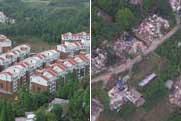China
How Does the 1959 Armed Rebellion Occur?
Source: China.org.cn | 04-28-2008 15:07
Before peaceful liberation in 1951, Tibet was under a feudal serfdom characterized by the dictatorship of upper-class monks and nobles. The broad masses of serfs in Tibet eagerly wanted to break the shackles of serfdom. After the peaceful liberation, many enlightened people of the upper and middle classes also realized that if the old system was not reformed, the Tibetan people would never attain prosperity. In light of Tibetan history and the region's special situation, the central people's government adopted a very circumspect attitude toward the reform of the social system in Tibet. The 17-Article Agreement stipulated that the central government would not use coercion to implement such reform and that it was to be carried out by the Tibetan local government on its own. During his visit to India in January 1957, Premier Zhou Enlai of the State Council handed a letter from Chairman Mao Zedong to the Dalai Lama and Bainqen Lama and the accompanying Tibetan local government senior officials. The letter informed them of the decision of the central authorities that reform would not be conducted during the Second Five-Year Plan period (1958-62); whether reform should be conducted after six years would still be decided by Tibet according to its own situation and conditions then.
However, some members of the Tibetan ruling class were hostile to reform and wanted to preserve the serfdom forever so as to maintain their own vested interests. They deliberately violated and sabotaged the 17-Article Agreement and intensified their efforts to split the motherland. Between March and April 1952, Sicab Lukangwa and Losang Zhaxi of the Tibetan local government gave secret support to the illicit organization "the people's conference" to oppose the 17-Article Agreement and create disturbance in Lhasa, demanding that the PLA "pull out of Tibet." In 1955, Galoin Surkang Wangqen Geleg of the Tibetan local government and others secretly plotted an armed rebellion in the Tibetan-inhabited area of Xikang Province. Rebellion broke out in that area in 1956 and the rebels besieged the local government institutions and massacred hundreds of government staff as well as common people. In May 1957, with the support of Galoins Neuxar Tubdain Tarba and Xainga Gyurme Doje, a rebel organization named "four rivers and six ranges" and later the rebel armed forces named "religion guards" were founded. They raised the slogan of "Tibetan Independence" and "opposition to reform" and further intensified their rebellious activities. The armed rebels harassed Qamdo, Dengqen, Heihe and Shannan. They killed cadres, disrupted communication lines, and attacked institutions and army troops stationed there by the central authorities. They looted, cruelly persecuted people and raped women. A merchant named Dongda Bazha in Nedong County was captured together with his wife because he refused to take part in the rebellion. The rebels tied up the couple and lashed them before killing the husband and raping his wife. The then Tibetan local government admitted that many Tibetan people lodged complaints against the rebels with it. In August 1958 alone, there were more than 70 complaints.
The central people's government, in the spirit of national unity, repeatedly urged the Tibetan local government to punish the rebels to maintain public order. Meanwhile, it told the Galoins of the Tibetan local government, "The central government will not change its decision on postponing reform in Tibet and in the future, when the reform is conducted, the policy to be followed will still be one of peaceful reform." However, the reactionary clique of the upper social strata in Tibet took the extreme forbearance of the central government as a sign of weakness and easiness to bully. They declared, "For nine years, the Hans have not dared to touch our most glorious and sacrosanct system. When we attacked them, they could only parry our blows without being able to strike back. So long as we transfer a large number of troops to Lhasa from outside, the Hans will surely flee at the first blow. If they don't run away, we will carry His Holiness the Dalai Lama to Shannan, and gather our strength there to launch a counter-attack and seize back Lhasa. If all these efforts fail, we can go to India."
The armed rebellion in Tibet was supported from the beginning by foreign anti-China forces. In his book The United States, Tibet and China American Norman C. Hall reveals that in 1957 the CIA culled six young men from among Tibetans residing abroad and sent them to Guam of the United States to receive training in map-reading, radio transmission, shooting and parachuting. Subsequently, the United States trained 170 "Kamba guerrillas" in batches in Hale Camp, Colorado. The trained "Kamba guerrillas" were air-dropped or sneaked into Tibet to "launch an effective resistance movement" to "oppose the Chinese occupation." An article entitled The CIA Tibetan Conspiracy in theHong Kong-based Far Eastern Economic Review disclosed in its September 5 issue of 1975 that in May 1958, two agents trained by the Americans in the first batch brought a transceiver to the headquarter set up by the rebel leader Anzhugcang Goinbo Zhaxi in Shannan to make contact with the CIA. Before long, the United States air-dropped arms and ammunition, including 20 sub-machine guns, two mortars, 100 rifles, 600 hand-grenades, 600 artillery shells and close to 40,000 bullets, to the rebels in the plateau called Chigu Lama Thang. During the same period, the United States clandestinely shipped large amounts of arms and ammunition overland to the rebels entrenched in the Shannan area.
With the collusion of the Tibetan serf-owners bent on retaining serfdom and the foreign anti-China forces, the rebellious activities soon became rampant. The climax was the elaborately planned armed rebellion in Lhasa on March 10, 1959.



